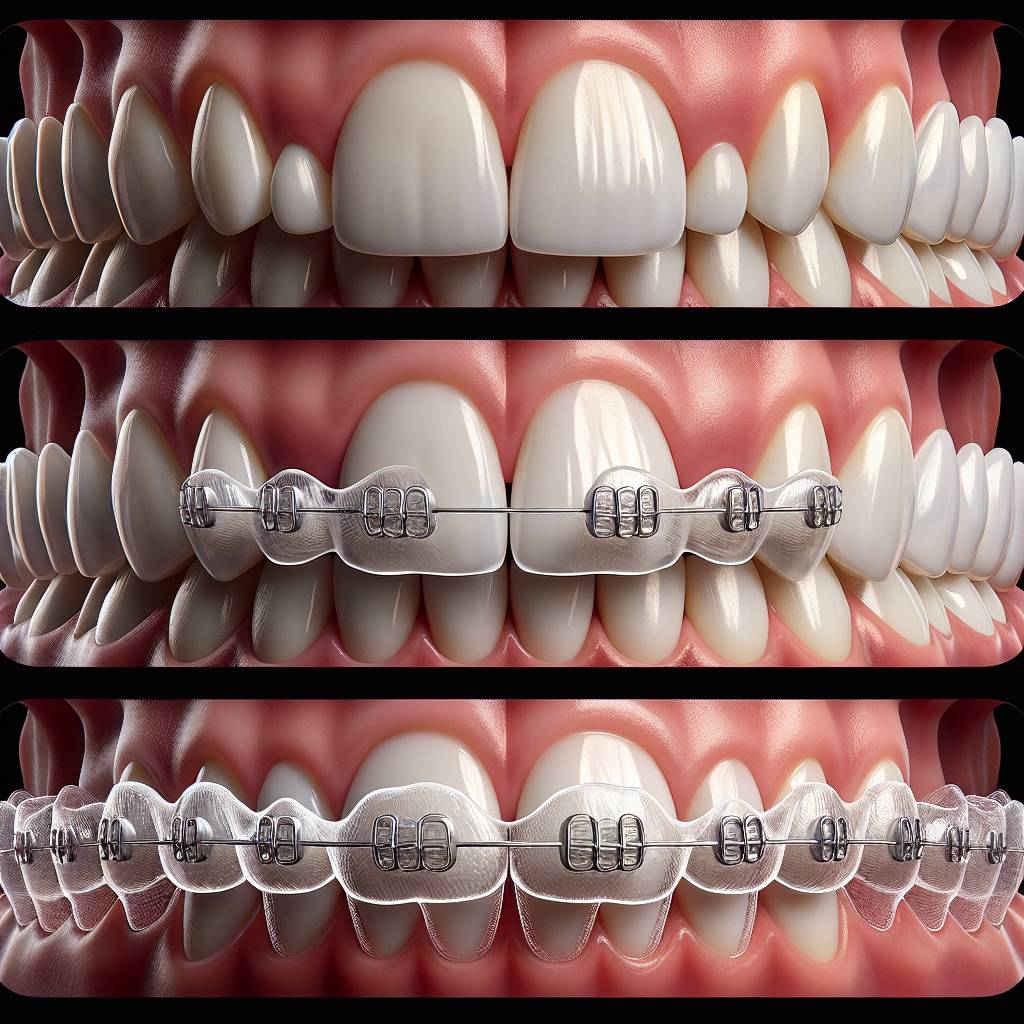Invisalign is an increasingly popular teeth straightening treatment. It offers a discreet, comfortable and almost invisible way to get your teeth in line. Many people want to know how long it takes Invisalign to close the gap between their teeth. The answer depends on the individual but, in general, it usually takes between 6 and 18 months for Invisalign to correct gaps between teeth.Invisalign is a type of orthodontic treatment that uses custom-made clear aligners to gradually shift teeth into their desired positions. It is an effective and discreet alternative to traditional metal braces, and can be used to close gaps in teeth. Each aligner is designed specifically for an individual patient and is made from a smooth, comfortable plastic material. The aligners are worn for around two weeks at a time before being replaced with the next in the series. Throughout the course of treatment, they slowly move the teeth into their desired positions. Invisalign can effectively close gaps in teeth and improve the overall appearance of a smile.
The Benefits of Invisalign for Closing Gaps in Teeth
Invisalign is a popular orthodontic treatment option that improves the appearance of a person’s smile by closing unwanted gaps between teeth. This treatment option is becoming increasingly popular due to its many benefits, which include being virtually invisible, being more comfortable than traditional braces, and offering shorter treatment times.
One of the most obvious benefits to using Invisalign to close gaps in teeth is that it is virtually invisible. Unlike traditional metal braces, which are highly visible on the teeth, Invisalign uses clear plastic aligners that are so discreet that they are often referred to as “invisible” braces. These aligners are custom-made for each individual patient and fit snugly over their teeth. As a result, no one will be able to tell that a person is wearing them unless they look very closely.
In addition to being virtually invisible, Invisalign is much more comfortable than traditional metal braces. Metal braces can be uncomfortable and painful due to the brackets and wires used to move the teeth into place. With Invisalign, there are no brackets or wires used; instead, the aligners are made from clear plastic and fit snugly over the teeth. This makes them much more comfortable than metal braces as there are no sharp edges or wires poking and prodding at the mouth.
Finally, Invisalign offers shorter treatment times when compared to traditional metal braces. Metal braces can take years before they achieve their desired results whereas Invisalign typically takes only 12-18 months for most patients. This means that patients can enjoy their new smile much sooner than with traditional orthodontic treatments.
In conclusion, Invisalign offers many great benefits when it comes to closing gaps in teeth including being virtually invisible, more comfortable than traditional metal braces and offering shorter treatment times when compared to other orthodontic treatments such as metal braces. For those looking for an effective way to close unwanted gaps in their teeth without having to endure long treatment times or uncomfortable metal braces, Invisalign may be the perfect solution.
What Causes Gaps in Teeth?
Gaps between teeth, also known as diastema, can be caused by a variety of factors. Genetics is one of the most common causes, and if multiple family members have gaps in their teeth, it is likely that the trait has been passed down. Other causes of gaps between teeth include overcrowding, incorrect jaw positioning, tongue thrusting, and thumb sucking.
Gaps in teeth can occur if there is not enough space for all the teeth to fit properly. When this occurs, the teeth may become crooked or crowded and a gap can form between them. Jaw misalignment can also cause gaps between teeth as the jaw may be too small to accommodate all of the adult teeth or too far back so that some adult teeth do not fit correctly.
Tongue thrusting is another common cause of gaps in teeth. This occurs when someone constantly pushes their tongue against their front teeth when speaking or swallowing, which can eventually lead to a gap forming between them over time. Thumb sucking is another factor that can cause gaps in teeth as the constant pressure on the front upper and lower teeth can affect their positioning and create a space between them.
Overall, there are many causes of gaps in teeth including genetics, overcrowding, incorrect jaw positioning, tongue thrusting, and thumb sucking. If you have any concerns about your own dental health it is important to visit your dentist for advice and treatment options.
How Long Does Invisalign Take to Close Gaps in Teeth?
Invisalign is an increasingly popular orthodontic treatment option designed to help patients achieve straight, beautiful smiles. One of the main benefits of Invisalign is the ability to correct gaps in teeth and other misalignment issues without the use of traditional metal braces. But how long does it typically take for Invisalign to close gaps in teeth?
The answer depends on several factors, including the size of the gap and the severity of misalignment. Generally speaking, most patients can expect to see results within six months to a year. However, some patients may require additional time or more frequent visits for follow-up adjustments.
In order to determine how long it will take for Invisalign to close gaps in teeth, patients must first have a consultation with their orthodontist. During this appointment, your orthodontist will evaluate your teeth and bite and create a customized treatment plan designed specifically for your needs. This plan will include information on which type of aligners you’ll need (trays that shift your teeth gradually), how often they will need to be changed, and how long you can expect treatment to last.
During the course of your Invisalign treatment, you’ll need regular check-ups at your orthodontist’s office every four-to-six weeks. At these appointments, your orthodontist will monitor progress and make any necessary adjustments or changes to ensure that treatment progresses as planned.
It’s important to note that while most patients can expect to see results within six months to a year, some cases may require longer treatment periods depending on individual circumstances. Additionally, many patients find that wearing their aligners as directed by their orthodontist helps speed up treatment time.
In summary, while each patient’s experience with Invisalign is unique, most people can expect results within six months to a year when wearing aligners as directed by their orthodontist. Since every case is different though, it’s best to consult with an experienced orthodontic professional who can provide accurate estimates based on individual needs and circumstances.
Factors Affecting the Length of Invisalign Treatment for Closing Gaps in Teeth
The length of Invisalign treatment for closing gaps in teeth depends on several factors, such as the severity of the gap, the patient’s commitment to wearing the aligners, and the type of plan chosen. The severity of a gap is determined by how much space is between two or more teeth. If there is a large gap between two or more teeth, it may take longer to close them with Invisalign than if there was a smaller gap. Additionally, if a patient is not committed to wearing their aligners as prescribed by their doctor, this can significantly lengthen the treatment time. Finally, depending on the type of Invisalign plan chosen, different lengths of treatment may be available. Some plans may take longer than others due to their complexity and number of aligners used.
In conclusion, several factors can affect the length of Invisalign treatment for closing gaps in teeth. These include the severity of the gap, patient commitment to wearing their aligners as prescribed by their doctor, and the type of plan chosen. By understanding these factors and working closely with an orthodontist who specializes in Invisalign treatment, patients can ensure that they receive an optimal outcome from their treatment plan.

How to Prepare for Invisalign Treatment for Closing Gap in Teeth
Invisible braces, also known as Invisalign, are becoming increasingly popular as a way to close gaps in teeth and achieve a beautiful smile. Invisalign is an orthodontic treatment system that uses clear aligners to gradually move teeth into their desired position. The treatment is designed to be more comfortable and discreet than traditional metal braces. Preparing for Invisalign treatment can help ensure a successful outcome and reduce the risk of complications.
Before beginning Invisalign treatment, it is important to consult with your dentist or orthodontist. During the consultation, your dentist will evaluate your teeth and determine if you are a good candidate for Invisalign. Your dentist will also discuss the expected outcome of the treatment and any potential risks or side effects. After the consultation, you will be able to decide if Invisalign is right for you.
Once you have decided to proceed with Invisalign treatment, it is important to prepare for the process. The first step is to make sure all necessary dental work has been completed prior to beginning the treatment. This includes having any cavities filled or crowns placed on your teeth prior to the start of treatment. Additionally, it may be necessary to have your teeth professionally cleaned before starting Invisalign in order to remove any plaque or tartar buildup that could complicate the process.
It is also important to prepare yourself mentally for Invisalign treatment. The process can take several months, so it is important that you are committed and willing to follow through with all appointments and instructions from your dentist or orthodontist. Additionally, it may be helpful to set short-term goals during the course of treatment in order to stay motivated and on track with achieving the desired results.
Finally, it is important that you practice good oral hygiene while undergoing Invisalign treatment in order to ensure a successful outcome. This includes brushing twice daily with fluoride toothpaste and flossing regularly in order to prevent plaque buildup on your teeth which can cause staining or discoloration during the course of treatment. Additionally, wearing retainers after completing Invisalign can help maintain your new smile over time by preventing shifting of your teeth back into their original positions after completion of treatment.
Is Invisalign Suitable for Closing Gap in Teeth?
Yes, Invisalign is an excellent choice for closing gaps in teeth. Invisalign is a modern orthodontic treatment that uses a series of clear, removable aligners to gradually reposition the teeth. It is almost entirely invisible when worn, making it a much more discreet and aesthetically pleasing option than traditional braces. Invisalign can be used to close gaps between the teeth, as well as to correct other orthodontic issues such as crowding or misalignment.
Before starting treatment with Invisalign, you will have an initial consultation with your dentist or orthodontist to discuss your goals and determine if the aligners are suitable for your needs. Your dentist will take impressions of your teeth and create a 3D simulation of how they should look once treatment is concluded. This simulation will help you get an idea of how your smile will look after the treatment is complete.
Once you have been approved for Invisalign treatment, you will receive several sets of aligners throughout the course of your treatment. Each set should be worn for at least 22 hours per day and switched out every two weeks until the desired results are achieved. During this time, it is important to keep up with regular dental visits so that your dentist can monitor the progress of the aligners and make any necessary adjustments.
Invisalign is a great option for closing gaps in teeth because it is much more comfortable than traditional braces and can provide excellent results in a relatively short amount of time. However, since each case is unique, it’s important to speak with your dentist or orthodontist to determine if this type of treatment would be suitable for you.
Are There Any Alternatives to Invisalign for Closing Gap in Teeth?
Closing the gap between teeth is a common dental issue that can be easily fixed with the help of orthodontic treatments such as Invisalign. However, there are other alternatives to Invisalign that can be used to close the gap in teeth.
One such alternative is braces. Braces are a type of orthodontic treatment that uses metal wires and brackets to move the teeth into the desired position. Braces come in various types such as traditional metal braces, ceramic braces, and lingual braces. Traditional metal braces are made of stainless steel brackets and wires, while ceramic braces are made of tooth-colored materials which make them less noticeable on the teeth. Lingual braces are placed on the back side of the teeth, making them completely invisible from the front.
Another alternative to Invisalign is clear aligners. Clear aligners are custom-made trays that fit over your teeth and gradually move them into their desired position over time. Unlike traditional braces, clear aligners are removable so you can take them out whenever you eat or brush your teeth.
For people with minor spacing issues between their teeth, a retainer may be an option as well. Retainers are designed to keep your teeth in place after orthodontic treatments or surgery have been completed. They come in both fixed and removable varieties, depending on your needs and preferences.
Finally, another option for closing gaps between teeth is bonding or contouring. Bonding involves using a special composite material to fill gaps between your teeth while contouring involves reshaping your tooth structure with specialized dental tools to close gaps and give you a more even smile.
Overall, there are numerous alternatives to Invisalign for closing gaps in teeth depending on your needs and preferences. It’s best to consult with an experienced dentist who can assess your case and recommend the best treatment option for you.

Conclusion
Invisalign is an effective and fast way to close gaps in teeth. It typically takes between 6-18 months to complete treatment, depending on the severity of the gaps and other factors. Orthodontists may use different methods to achieve desired results, such as using attachments, power ridges, or Invisalign attachments. Patients should closely follow their orthodontist’s instructions for wearing their aligners and schedule regular check-ups to ensure that the treatment is progressing as expected.
Overall, Invisalign can effectively close gaps in teeth without the need for metal braces. It’s a safe and comfortable option with relatively short treatment times compared to traditional braces. With proper care and regular check-ups with your orthodontist, you can expect to see results within 6-18 months.

